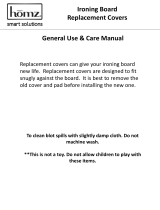
BEFORE USING THE WASHING MACHINE
1.Removing the packaging and check
•
After unpacking, make sure that the washing
machine is undamaged. If in doubt, do not use the
washing machine. Contact After-Sales Service or
your local retailer.
•
Keep the packaging materials (plastic bags,
polystyrene parts, etc.) out of reach of children, as
they are potentially dangerous.
2.Remove the transit bolts
•
The appliance is fitted with transit bolts to prevent
internal damage during transport.
Before using the
washing machine you must remove the transit
bolts
(see “Installation/Remove the transit bolts”).
3.Install the washing machine
•
Remove the protective foil from the control panel.
•
Move the machine without carrying it at the top.
•
Install the appliance on a solid and level floor
surface, preferably in a corner of the room.
•
Adjust the feet to ensure that the machine is stable
and level (see "Installation/Adjust the feet").
4.Water supply
•
Connect the water supply inlet hose in accordance
with regulations of your local water company (see
“Installation/Connect the water inlet hose”).
•
Water supply: cold water only
•
Tap: 3/4” threaded hose connection
•
Pressure: 100-1000 kPa (1-10 bar).
For Great Britain & Ireland only:
•
Water inlet: hot and cold fill.
The warm water inlet temperature must not exceed
60°C.
5.Drain hose
•
Connect the drain hose to the siphon or hook it over
the edge of a sink by means of the “U” bend (see
“Installation/Connect the water drain hose”).
•
If the washing machine is connected to a built-in
drainage system, ensure the latter is equipped with
a vent to avoid simultaneous loading and draining
of water (siphoning effect).
6.Electrical connections
•
Electrical connections must be carried out by a
qualified technician in compliance with the
manufacturer's instructions and current standard
safety regulations.
•
Voltage information, power consumption and
electrical protection data are supplied on the inside
of the appliance door.
•
The appliance must be connected to the mains
exclusively by means of a socket with an earth
connection in accordance with established
regulations. The appliance must be earthed by law.
The manufacturer declines all liability for damage to
property or injury to persons or animals deriving
either directly or indirectly from failure to observe
the directions.
•
Do not use extension leads or multi sockets.
•
Before any maintenance on the washing machine
disconnect it from the mains supply.
•
Access to the mains plug or to disconnection from
mains supply via a double-pole switch must be
ensured at all times following the installation.
•
Do not operate the washing machine if it has been
damaged during transport. Inform the After-Sales
Service.
•
Mains cable replacement is only to be carried out by
After-Sales Service.
•
The washing machine must only be used in the
household for the prescribed uses.
Minimum housing dimensions:
Width:600 mm
Height:825 mm
Depth:600 mm




















